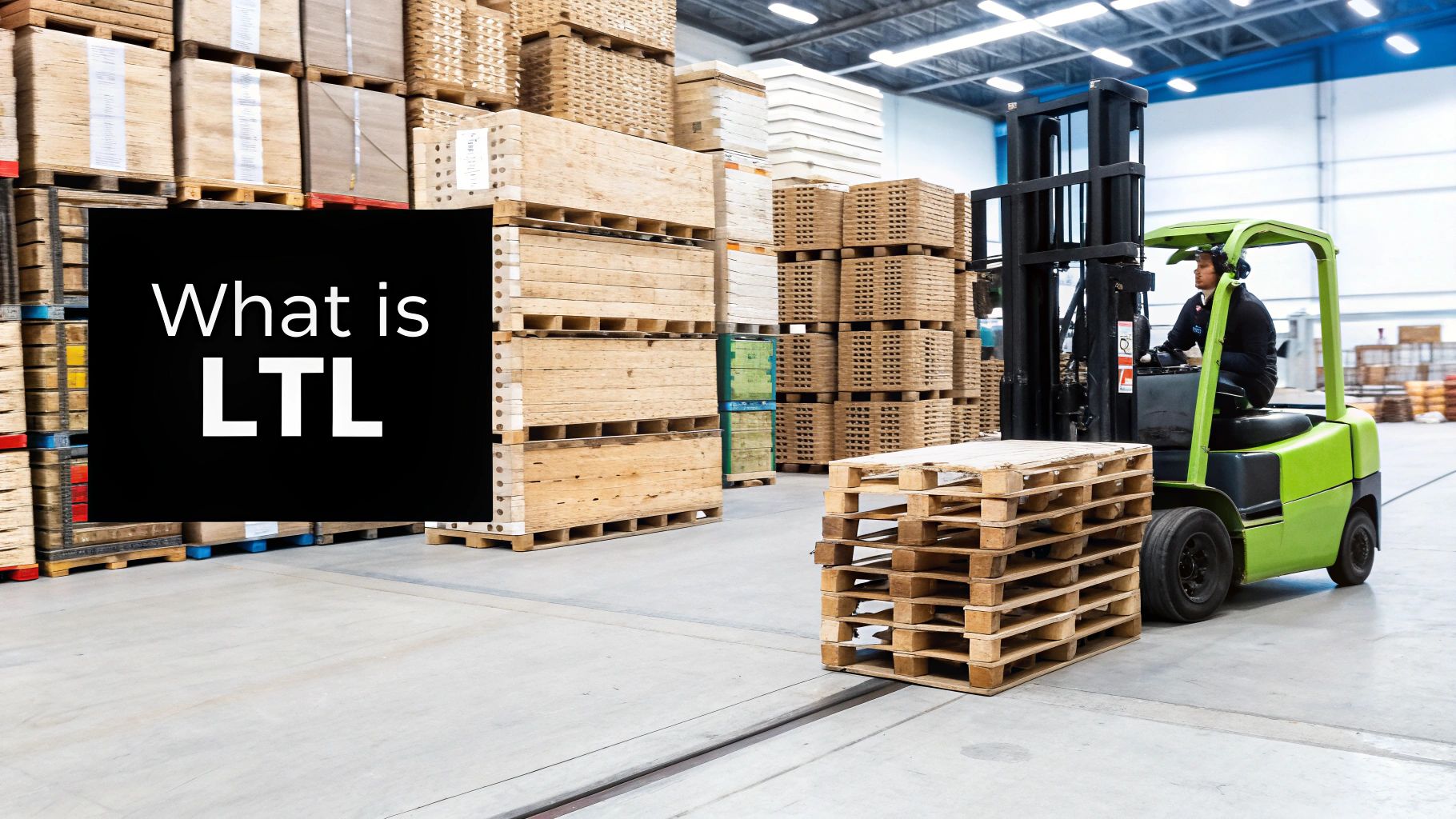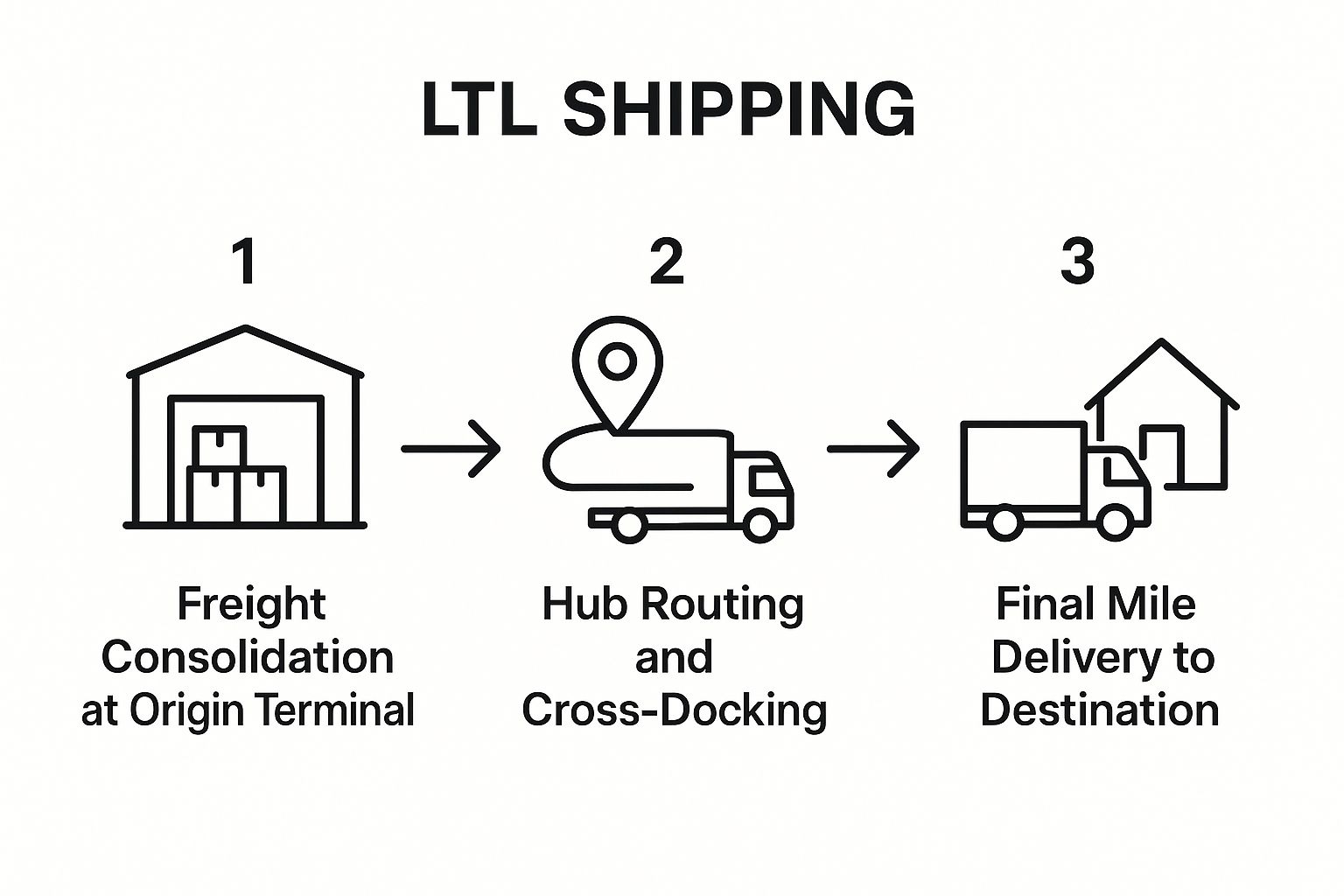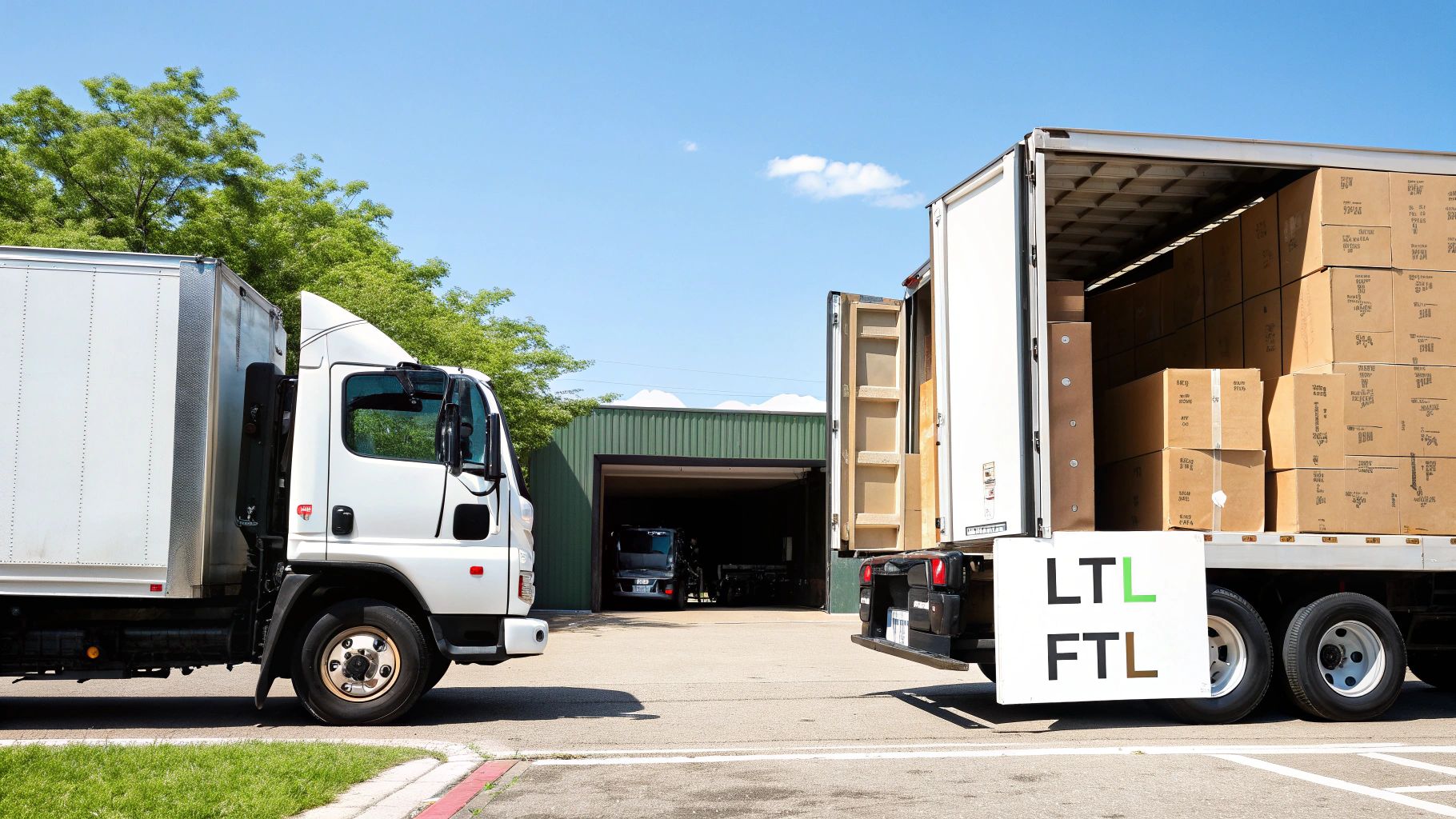Wondering what does LTL stand for in shipping? Learn how Less Than Truckload freight saves money and how the process works from start to finish.

So, what in the world is LTL shipping? The acronym stands for Less Than Truckload, but that doesn't tell the whole story.
Let's use an analogy. Think of it like a rideshare for your freight. Instead of hiring a whole private bus (a full truck) just for your small group, you share the ride—and the cost—with other people heading in the same general direction. It's a smart, efficient way to move your goods without paying for empty space.

LTL shipping is the perfect solution for shipments that are too heavy or bulky for services like UPS or FedEx but don't quite fill up a 53-foot trailer. We're talking about freight that typically weighs between 150 and 15,000 pounds.
Essentially, LTL carriers combine shipments from several different customers onto a single truck. This shared-space model is what makes it such a game-changer for businesses wanting to keep their logistics costs in check.
The core idea is all about efficiency. Your freight gets picked up and taken to a local terminal, where it's sorted with other shipments. From there, it's loaded onto a long-haul truck with other pallets heading to the same regional hub. Once it arrives, it's sorted again and placed on a smaller, local truck for final delivery.
This entire network of pickups, sorting hubs, and deliveries is managed by a specialized LTL carrier. These companies have the infrastructure to make this complex dance run smoothly.
The Bottom Line: With LTL, you only pay for the specific space your pallets take up on the truck. This turns shipping from a massive, fixed cost into a flexible expense that scales with your actual needs.
To put it all in perspective, here’s a quick rundown of the essential LTL characteristics.
This shared model is what makes LTL such a powerful tool for so many businesses. Ready to see how much you could save on your next FTL or LTL shipment?
So, your shipment is loaded and the truck pulls away from the dock. What happens next? It’s not as simple as one truck driving from point A to point B. The LTL process is actually a highly coordinated dance, a bit like how airlines manage passenger flights.
Think about it this way: instead of a direct flight, passengers often have a layover at a major airport hub. LTL freight works on a very similar "hub and spoke" system. Your pallets will likely travel on a few different trucks and pass through a couple of terminals before they reach their final destination.
It all starts with the pickup. A local truck swings by your location to collect your freight. This is the moment your Bill of Lading (BOL) comes into play. Treat this document like a passport for your shipment; it’s the all-important contract and receipt that details everything about the freight, its origin, and its destination.
From there, your shipment is whisked away to a local origin terminal. Here, it’s unloaded and sorted with other freight bound for the same general region. This is the consolidation part of the process, and understanding the different kinds of LTL freight loads can really help you get the most bang for your buck.
This infographic breaks down the key steps in the LTL journey.

As you can see, the freight gets handled multiple times at these terminals. This is completely normal for LTL, and it’s why making sure your pallets are properly packed and secured is so incredibly important.
Once your shipment arrives at the destination terminal, it gets unloaded and sorted one last time. A smaller, local truck then takes over, handling that "last mile" to bring it right to the consignee's door. Journey complete.

Knowing what LTL means is one thing, but knowing when to use it is where you really start saving money and avoiding logistical nightmares. When you're standing at the shipping crossroads, your choice usually boils down to three paths: LTL, Full Truckload (FTL), or standard parcel shipping.
Let's make this tangible. Imagine you own a small, growing furniture business. Each shipping method has a specific job to do.
This simple logic is the foundation of smart, cost-effective shipping. It’s all about matching the size of your shipment to the right-sized service.
To make your decision even easier, let's break down the key differences between these three core methods. Think of this as your go-to cheat sheet for picking the perfect service every single time.
Here's a detailed comparison to help you decide which shipping service fits your needs. Each option offers unique benefits based on the size, urgency, and handling requirements of your freight.
As you can see, LTL masterfully fills that critical gap for businesses whose shipping needs have outgrown parcel but don't yet justify a dedicated truck. Whether you need an LTL or FTL rate, compare your options instantly.
Of course, sometimes the job is even bigger than just moving inventory. For entire facility moves, you'll want to look into specialized commercial moving services that are equipped to handle that level of complexity.
Let's get straight to the point: the biggest reason businesses get hooked on LTL freight is because it saves a ton of money. It’s that simple. Instead of footing the bill for a whole truck you can’t even fill, you just pay for the space your pallets take up. This shared-cost approach is a game-changer, especially for small and mid-sized companies.
When you're splitting the cost of a truck ride with other businesses, your shipping budget suddenly stretches a lot further. For shipments weighing between 500 and 10,000 pounds, LTL can easily be 40-50% cheaper than booking a full truck. That turns what could be a massive operational headache into a predictable, manageable expense. You can see a detailed breakdown of these LTL cost benefits and how they stack up for different load sizes.
But honestly, the perks of LTL go way beyond just saving cash.
Choosing LTL opens up a few other clever advantages that help you run a tighter, more secure operation.
Better Security: When you secure your goods on a pallet and shrink-wrap them, you create a solid, stable block. This simple step dramatically cuts down on the risk of something getting damaged along the way, which is a common worry with loose, individual boxes.
Greater Flexibility: LTL carriers are known for offering a whole menu of special services that you just don't get with FTL. Need a liftgate because your delivery spot doesn't have a loading dock? No problem. Sending something to a residential address? LTL has you covered.
A Greener Footprint: Believe it or not, the LTL model is naturally more eco-friendly. By combining freight from several companies onto one truck, we're putting fewer vehicles on the road to move the same amount of stuff. That means less fuel burned and lower carbon emissions—a win for your budget and the planet.
Thinking about how these benefits could impact your shipping costs? Find out in minutes with a free FTL or LTL freight quote.

Figuring out LTL pricing can feel a bit like solving a puzzle, but it's much simpler once you know what to look for. Several key pieces come together to determine your final rate, and understanding them gives you a major advantage.
The most obvious factors are weight and distance. It just makes sense—heavier shipments traveling farther will cost more. But there's another piece to this puzzle that often has the biggest impact on your bill: freight class.
Think of freight class as a universal language for all shippable goods. It's a standardized system that helps carriers price shipments fairly and consistently, no matter what you're sending. This system is officially called the National Motor Freight Classification (NMFC), and it assigns a class number to every commodity imaginable.
These numbers range from a low of 50 to a high of 500. The lower the class, the cheaper it is to ship. This number is determined by four key characteristics:
A great example is comparing a pallet of bricks to a pallet of ping pong balls. The heavy, durable bricks might be Class 50 (the cheapest), while the light, fragile, and bulky ping pong balls could be Class 500 (the most expensive).
Getting the freight class right is the single most important step for an accurate quote. Our guide on how to use an LTL freight quote calculator dives deeper into how these details add up. For more advanced planning, a shipping cost predictor tool can also be a huge help.
Once you get a handle on these factors, you can start reading quotes with confidence and find ways to ship more efficiently.
Alright, so you’ve got the basics of Less Than Truckload shipping down. But let's be real—the theory is one thing, and actually getting your freight on the road is another. Here are some straightforward answers to the questions we get asked all the time.
This is a big one, because your freight class is a major driver of your shipping cost. The quickest way to get an answer is to use an online freight class calculator, which you can find on most carrier or broker websites. You’ll just need the final dimensions and weight of your shipment after it's all packed up on the pallet.
The calculation itself is based on four key things: density, stowability, handling, and liability. If you're shipping something unusual or just aren't sure, your best bet is to talk directly with your shipping partner. Nailing down the right freight class from the get-go is the secret to avoiding those surprise billing adjustments later on.
Proper packaging is your shipment's first line of defense. Remember, LTL freight gets moved around quite a bit at different terminals, so you want to make sure your goods are buttoned up tight.
Here's a simple checklist:
A few extra minutes spent on prep can save you a world of headaches down the line.
There isn't a hard-and-fast rule that applies everywhere, but a typical LTL shipment is anywhere from one to six pallets, weighing between 150 and 15,000 pounds.
If you're pushing past those numbers—say, your freight takes up more than 12-14 linear feet of the truck—it’s time to look at other options. You might find that "Volume LTL" or even booking a full truckload (FTL) is cheaper. A good freight broker can run the numbers for you and show you which option makes the most sense for that specific load.
Think of it this way: With LTL, you're sharing the truck and splitting the bill. With FTL, the whole truck is yours, which is why it's faster and more secure for bigger or more valuable shipments.
Ready to see how your options stack up? Get a quick, no-strings-attached quote today and find the smartest way to move your LTL or FTL freight.